Content
- 1 How to understand mountain ash?
- 2 Titanium
- 3 Bead
- 4 Likernaya Michurina
- 5 Ruby
- 6 Scarlet large
- 7 White, yellow and orange decorative varieties
- 7.1 Rubin
- 7.2 Nero
- 7.3 Black-eyed
- 7.4 Aronia Michurina
- 7.5 Viking
- 7.6 Hugin
- 7.7 Pomegranate
- 7.8 Bead
- 7.9 Ruby
- 7.10 Scarlet large
- 7.11 Titanium
- 7.12 Twinkle
- 7.13 Burka
- 7.14 Scarlet large
- 7.15 Bead
- 7.16 Pomegranate
- 7.17 Vefed
- 7.18 Sorbinka
- 7.19 Dessert Michurina
- 7.20 Likernaya Michurina
- 7.21 Cuba's daughter
- 7.22 Sugar Petrova
- 7.23 Nevezhinskaya
- 7.24 Solar
- 7.25 Moravian
- 7.26 Vefed
- 7.27 Burka
- 7.28 Gorgeous
Forest rowan is an extremely useful plant... Both the honey plant and its wood are beautiful, and feeds the birds in winter, and is also good-looking.
One problem: although its fruits are medicinal, they are bitter... Therefore, they are considered of little value. But this is if you take the wild game, the common mountain ash.
Varietal is a completely different matter... About her and speech.
How to understand mountain ash?
Our common, ubiquitous red rowan belongs to the large botanical genus Sorbus... In turn, almost all modern cultivars have their ancestry from this plant.
Rather, from two of its varieties-varieties: Moravian (Central Europe) and Nevezhin (Eastern Europe).
Moravian mountain ash discovered in the Czech Republic in the 19th century and named after the region where it was found - Moravia. Its sweet fruits, 1 cm in diameter, made this variety interesting for breeders.
From it came, for example, the varieties Edulis, Bissneri and Concentra.
 Almost all modern cultivated varieties have their ancestry from two varieties-varieties of mountain ash - Moravian and Nevezhinsky.
Almost all modern cultivated varieties have their ancestry from two varieties-varieties of mountain ash - Moravian and Nevezhinsky.
Nevezhinsky clone was also found by accident - in a forest near the village of Nevezhino, Vladimir region. Sweet, completely without bitterness, the fruits conquered the local peasants, who quickly realized to plant this mountain ash and sell seedlings to neighbors.
And this also happened in the 19th century. So almost at the same time, in both ends of Europe, nature gave a person a sweet mountain ash instead of a bitter one.
Sometimes nevezhinskaya mountain ash is called "nezhinskaya"... Everyone was confused by the wine merchant Fyodor Smirnov, who in the old days traded in tincture on its fruits. Not wanting to reveal the secrets of the recipe to competitors, he deliberately threw out one syllable and named his product "Nezhinskaya".
Ivan Vladimirovich Michurin was very interested in breeding high-quality mountain ash. Many of the varieties he created today have either been lost, or over-pollinated and lost their original characteristics, or are stored only in scientific collections. But those that have survived often become the basis for modern breeding work.
From a strictly scientific point of view, it is incorrect to call rowan fruits "berries". It is correct to say "apple". Fruits of the same type are formed by quince, apple and pear.
Titanium
This variety is one of the surviving Michurin creations.... It was created by a complex crossing of mountain ash, pear and red-leaved apple tree.
Its characteristics:
- Medium-sized tree (up to 5 meters) with a sparse rounded crown. Shoots are straight, the color of the bark is dull brown.
- Leaves are glossy, dark green.
- Inflorescences are scutes of medium diameter, the color of the petals is white.
- Fruits are slightly ribbed, rounded, weighing 1.2 grams. The skin is dark red, waxy. The pulp is yellow, sweet and sour, tart. The use is universal.
The Titan variety is frost- and drought-resistant, not affected by diseases.
 The rowan variety Titan was bred by Michurin, frost and drought resistant, is not affected by diseases
The rowan variety Titan was bred by Michurin, frost and drought resistant, is not affected by diseases
| The chemical composition of the fruit | |
| Sugar | 10,2% |
| Organic acids | 1,4% |
| Vitamin C | 33 mg / 100 g |
| Dry matter | 20% |
Bead
Variety created Candidate of Agricultural Sciences Tatiana Kirillovna Poplavskaya... Fanatically devoted to science, in the 70s of the XX century she was actively engaged in the search and restoration of the lost Michurin rowan varieties.
The bead is one of the first varieties that do not have a tinge of astringency.It is a product of free pollination of Nevezhinskaya mountain ash.
Characteristics and description of the variety:
- A plant of moderate growth, 3 meters high. Shoots are gray-brown, straight. Begins to bear fruit, according to various sources, at 3 or 5 years of age.
- Leaves are light green, serrated.
- The inflorescences are large, with white flowers.
- Fruits are regular, rounded, with a red skin, weighing 1.2-1.9 grams. The pulp is creamy, with a touch of cranberry flavor, but without strong acid. The appointment is universal. Ripen early, by the end of August.
Particularly valuable qualities of the variety - high resistance to extreme frosts, drought, diseases. The yield is high.
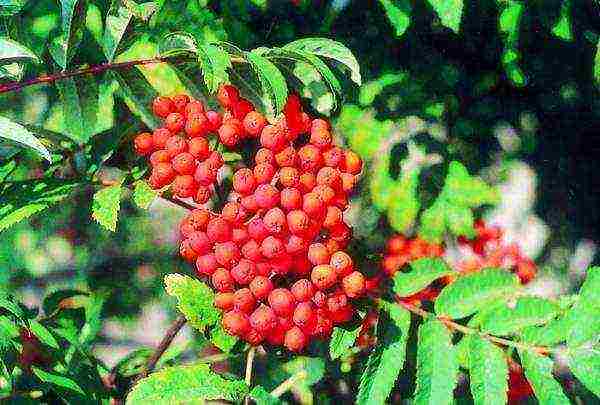 Rowan variety Businka has no astringency, is highly resistant to extreme frosts, drought, diseases
Rowan variety Businka has no astringency, is highly resistant to extreme frosts, drought, diseases
| The chemical composition of the fruit | |
| Sugar | 10% |
| Organic acids | 2,2% |
| Vitamin C | 67 mg / 100 g |
| Carotene | 9 mg / 100 g |
| Dry matter | 25% |
Likernaya Michurina
One of the Michurin varieties, lost and restored. It has a lot in common with one of its "parents" - chokeberry.
Characteristics of the rowan garden variety:
- Medium-sized plant, about 5 meters, with a sparse oval crown. Sometimes found in shrub form. Gives strong annual growth (up to 30 cm).
- Leaves are dark green, alternate, pinnate.
- Beautiful dense inflorescences with a shield diameter of 10 cm. The color of the petals is white-pink.
- Fruits are dark purple, almost black, weighing 1 g, ripen in September, stored for a month. The taste is reminiscent of blackberry - sweet, slightly astringent. Purpose - for making liqueur-type wines, jams.
Advantages of the variety: high winter hardiness and moderate drought resistance. Flaw: Fruit may rot.
 Rowan variety Likernaya bred by Michurin, excellent for making liqueur-type wines, jams
Rowan variety Likernaya bred by Michurin, excellent for making liqueur-type wines, jams
| The chemical composition of the fruit | |
| Sugar | 10,8% |
| Organic acids | 1,3% |
| Vitamin C | 15 mg / 100 g |
| Carotene | 2 mg / 100 g |
| Cellulose | 2.7 g / 100 g |
Ruby
The Michurin variety was also lost, but found, multiplied and transferred for variety testing to T.K. Poplavskaya. Like all old Michurin forms, this type of mountain ash has a slight astringency in taste.
Its characteristics:
- A low tree, 3 meters high, with a drooping crown. Skeletal branches are located almost at right angles, shoots are straight, with light brown integuments.
- The leaves are light green, with a finely serrated edge and a pubescent petiole.
- Scutellum not wide, flowers small, pinkish-white.
- Fruits are rounded-flattened, weighing 1.3 g. The skin is ruby-colored, the flesh is yellow. The taste is sweet and sour, slightly tart. The purpose of the fruit is for processing into juices, jellies, wines, liqueurs, jelly. Suitable for drying.
The plant is resistant to low temperatures.
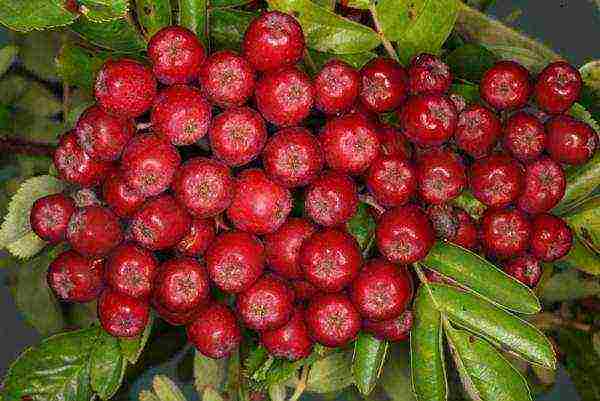 Rowan variety Rubinovaya is good for processing into juices, jellies, wines, liqueurs, jelly
Rowan variety Rubinovaya is good for processing into juices, jellies, wines, liqueurs, jelly
| The chemical composition of the fruit | |
| Sugar | 12,4% |
| Organic acids | 1,3% |
| Vitamin C | 21 mg / 100 g |
| Anthocyanins | 948 mg / 100 g |
Rubinovaya rowan fruits can replace raisins after drying. To do this, you need to place them in a gauze bag and hang them for a while by the battery.
Scarlet large
Variety bred by the Central Genetic Laboratory. Michurin (today the All-Russian Research Institute of Genetics and Breeding of Fruit Plants). An interesting, very effective plant, with really large fruits for a red-fruited mountain ash.
Variety characteristics:
- The height of the tree is 5 meters. Crohn of medium density, wide pyramidal shape. Poorly pubescent straight shoots with gray-brown bark and many large lentils.
- Leaves are dark green, with broad lanceolate plates, shiny.
- Wide scutes with a large number of flowers.
- Fruits from 1.7 to 2.5 grams, slightly ribbed, juicy. Scarlet skin, spicy taste, somewhat sour than other varieties, without bitterness. The appointment is dining and technical.
The variety is able to withstand extreme frosts down to -50⁰С. Resistant to diseases and pests.
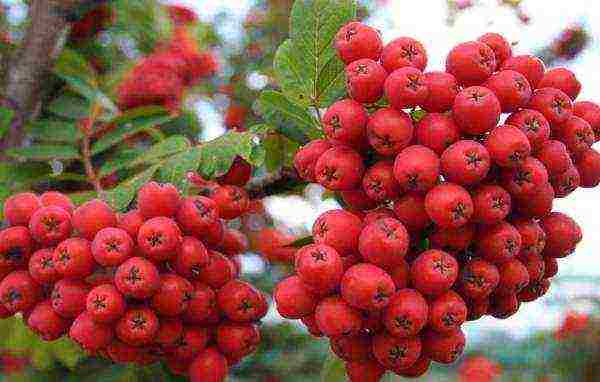 Large mountain ash variety Alai is capable of withstanding extreme frosts down to -50⁰С
Large mountain ash variety Alai is capable of withstanding extreme frosts down to -50⁰С
| The chemical composition of the fruit | |
| Sugar | 8,4% |
| Organic acids | 1,9% |
| Vitamin C | 21 mg / 100 g |
| Anthocyanins | 625 mg / 100 g |
White, yellow and orange decorative varieties
In addition to the usual red and black-fruited mountain ash, the efforts of breeders varieties with yellow, orange and even white fruits were bredthat can decorate any garden.
For example, grade Yellow with thin, flexible branches that, with a bountiful harvest, bend to the ground. From its fruits, rowan kvass, original fillings for pies and jams are obtained.
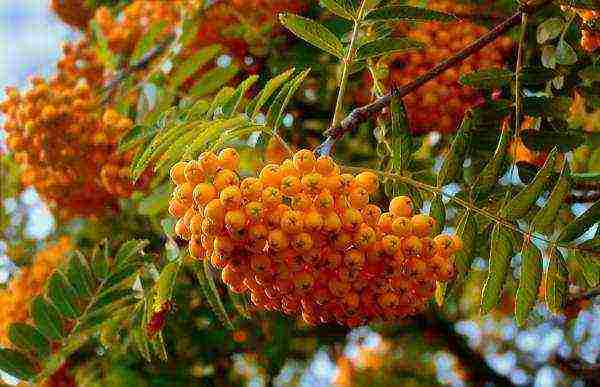 Rowan variety Yellow is good for making kvass, jam, as a filling for pies
Rowan variety Yellow is good for making kvass, jam, as a filling for pies
Of orange-fruited, it is very decorative grade Ogonyok - one of the most heat-resistant and drought-resistant. As it ripens, it changes the color of apples from yellow to fiery orange.
Rowan Daughter Kubova - new variety, bred by spontaneous hybridization of Nevezhinskaya Kubova. The fruits of this tree also have a bright orange color in the ripeness phase, and their taste is juicy, bright, sour-sweet, without a hint of bitterness or astringency.
Kubovaya itself also has orange fruits, but the yield is not so high. Cubic is a derived form from the nevezhin mountain ash, created through folk selection. Its apples are slightly elongated, pentahedral, with a very pleasant taste.
But white-fruited mountain ash, unfortunately, is not suitable for food. For example, the varieties Kene or White Swan have very bitter fruits... However, their compactness and high decorativeness makes it possible to create an interesting play of colors among other rowan trees.
 Ornamental white-fruited mountain ash varieties Kene or White Swan are not edible
Ornamental white-fruited mountain ash varieties Kene or White Swan are not edible
By combining in plantings, for example, high Scarlet, large, delicate Yellow and miniature White Swan, you can get a combination of benefits and beauty.
All varietal rowan berries are self-sterile. To get a high-quality harvest from them, you need to plant several different varieties next to each other or plant them in the crown of one tree.
 Rowan is one of the most frost-resistant fruit trees. More than a hundred species of mountain ash are known, and about a third of them can be seen on the territory of Russia. Breeders have bred many promising varieties that differ in color, size and shape of the fruit. There are two subgenera of mountain ash, which differ in the shape of the leaves. Representatives of the rowan subgenus are of the greatest interest. It was they who gave rise to varieties of garden rowan and it is their fruits that have nutritional and medicinal value. The second subgenus forms the basis for decorative varieties. Edible rowan berries are harvested in August-September. It takes up to 90 days to reach technical maturity. Ripening rates directly depend on weather conditions and on the growing region.
Rowan is one of the most frost-resistant fruit trees. More than a hundred species of mountain ash are known, and about a third of them can be seen on the territory of Russia. Breeders have bred many promising varieties that differ in color, size and shape of the fruit. There are two subgenera of mountain ash, which differ in the shape of the leaves. Representatives of the rowan subgenus are of the greatest interest. It was they who gave rise to varieties of garden rowan and it is their fruits that have nutritional and medicinal value. The second subgenus forms the basis for decorative varieties. Edible rowan berries are harvested in August-September. It takes up to 90 days to reach technical maturity. Ripening rates directly depend on weather conditions and on the growing region.
Chokeberry is a self-pollinated plant. Even if only one bush grows in the garden, it will bloom and bear fruit. Growing a bush from seeds is the longest, but simplest. Seeds are squeezed out of ripe berries, dried and stored in a dark place. Seeds are sown in the ground in autumn (September to October) or spring.
Rubin
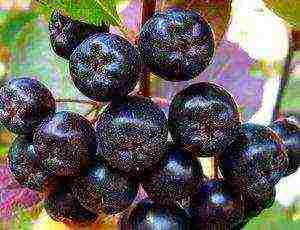 The variety has increased resistance to diseases, unpretentious care. Loves sunny areas. The berries are slightly tart. The variety is highly resistant to pests and diseases, frost-resistant. Rowan blossoms in early June. The berries ripen in September, have a rounded shape with a diameter of up to 1 cm. It is recommended to plant seedlings in autumn.
The variety has increased resistance to diseases, unpretentious care. Loves sunny areas. The berries are slightly tart. The variety is highly resistant to pests and diseases, frost-resistant. Rowan blossoms in early June. The berries ripen in September, have a rounded shape with a diameter of up to 1 cm. It is recommended to plant seedlings in autumn.
Nero
 Suitable for growing in climatic regions with harsh winters, as well as in shaded areas. The fruits contain an increased amount of vitamins. The variety gives delicious berries and is a real decoration of the garden area. The height of the plant does not exceed 2 m. The shape of the crown resembles a vase. White flowers have red stamens, which adds decorative effect.
Suitable for growing in climatic regions with harsh winters, as well as in shaded areas. The fruits contain an increased amount of vitamins. The variety gives delicious berries and is a real decoration of the garden area. The height of the plant does not exceed 2 m. The shape of the crown resembles a vase. White flowers have red stamens, which adds decorative effect.
Black-eyed
 Possesses increased resistance to diseases, mountain ash is not whimsical to care for. Loves sunny areas. The berries are not tart, unlike other varieties. Variety "Black-eyed" differs from others in the reduced astringency of berries. It blooms in early June and is a honey plant.The berries ripen in September, have a rounded shape, reach 1 cm in diameter. It is recommended to plant seedlings of the Black-eyed variety in autumn.
Possesses increased resistance to diseases, mountain ash is not whimsical to care for. Loves sunny areas. The berries are not tart, unlike other varieties. Variety "Black-eyed" differs from others in the reduced astringency of berries. It blooms in early June and is a honey plant.The berries ripen in September, have a rounded shape, reach 1 cm in diameter. It is recommended to plant seedlings of the Black-eyed variety in autumn.
Aronia Michurina
 The tree is more than 3 m high with a dense oval crown. Negoy has obovate leaves with an oval apex, this shape is slightly variable. Fruits are large, weighing up to 1.5 g, spherical, slightly flattened, black with a bluish matte bloom. They are juicy, edible, sour-sweet taste with astringency. "Aronia Michurina" can withstand winter temperature drops down to -40 ° С.
The tree is more than 3 m high with a dense oval crown. Negoy has obovate leaves with an oval apex, this shape is slightly variable. Fruits are large, weighing up to 1.5 g, spherical, slightly flattened, black with a bluish matte bloom. They are juicy, edible, sour-sweet taste with astringency. "Aronia Michurina" can withstand winter temperature drops down to -40 ° С.
Viking
 A small shrub with dark green leaves serrated at the edges. The variety blooms in May. Purple-black berries slightly less than 1 cm in diameter have a flat-round shape, ripen in autumn. The variety is distinguished by its yield and frost resistance. For planting seedlings, sunny areas are chosen, preference is given to loamy or sod-podzolic soils with a neutral environment.
A small shrub with dark green leaves serrated at the edges. The variety blooms in May. Purple-black berries slightly less than 1 cm in diameter have a flat-round shape, ripen in autumn. The variety is distinguished by its yield and frost resistance. For planting seedlings, sunny areas are chosen, preference is given to loamy or sod-podzolic soils with a neutral environment.
Hugin
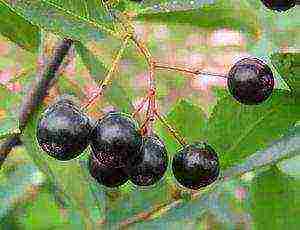 Shrub up to 2 m tall with a characteristic rounded crown. Planting seedlings is recommended only after the last frost. The leaves are dark green and shiny. Flowering is shifted to June. White flowers form lush inflorescences. Large black and red berries ripen in September. The plant is winter hardy. One of the features is the intolerance of strong pruning.
Shrub up to 2 m tall with a characteristic rounded crown. Planting seedlings is recommended only after the last frost. The leaves are dark green and shiny. Flowering is shifted to June. White flowers form lush inflorescences. Large black and red berries ripen in September. The plant is winter hardy. One of the features is the intolerance of strong pruning.
Red mountain ash is a fruit tree with bright red berries that can remain on branches from summer to late autumn and even all winter to spring. Rowan fruits contain many acids: citric, malic, sorbic, tartaric and succinic. In addition to acids, rowan fruits contain up to 5% sugar, carotene, bitter and tannins, ascorbic acid.
Pomegranate
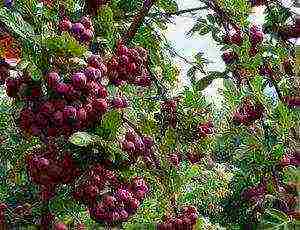 The variety combines the advantages of mountain ash and hawthorn. The plant is short, winter-hardy, very decorative. The fruits are burgundy, large - they are similar in size to cherries. The taste is sweet and sour, the yield is high.
The variety combines the advantages of mountain ash and hawthorn. The plant is short, winter-hardy, very decorative. The fruits are burgundy, large - they are similar in size to cherries. The taste is sweet and sour, the yield is high.
Bead
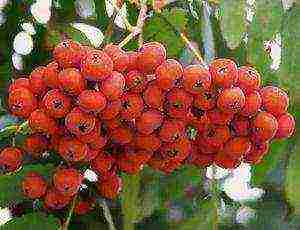 Medium-sized tree about 3 m high, with a rounded crown of medium density. A tree of moderate growth. Fruits are round, red, weighing up to 2 g. The pulp is creamy, very juicy, of medium density, sweet and sour taste without bitterness and astringency. The yield is high. Transportability is good. The fruit can be consumed fresh. The variety is sun-loving, frost and disease resistant.
Medium-sized tree about 3 m high, with a rounded crown of medium density. A tree of moderate growth. Fruits are round, red, weighing up to 2 g. The pulp is creamy, very juicy, of medium density, sweet and sour taste without bitterness and astringency. The yield is high. Transportability is good. The fruit can be consumed fresh. The variety is sun-loving, frost and disease resistant.
Ruby
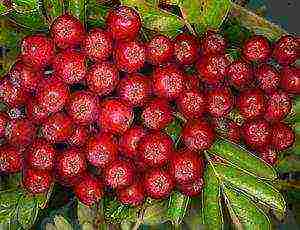 A variety of medium ripening. The tree is medium, up to 3 m. The crown is of medium density, drooping. Fruits with an average weight of 1.3 g, one-dimensional, flattened, with a smooth wide-ribbed surface, ruby color. The pulp is yellow, medium density, juicy, sweet and sour. The variety is resistant to low temperatures. The fruits are recommended to be used dried as dried fruits for compotes.
A variety of medium ripening. The tree is medium, up to 3 m. The crown is of medium density, drooping. Fruits with an average weight of 1.3 g, one-dimensional, flattened, with a smooth wide-ribbed surface, ruby color. The pulp is yellow, medium density, juicy, sweet and sour. The variety is resistant to low temperatures. The fruits are recommended to be used dried as dried fruits for compotes.
Scarlet large
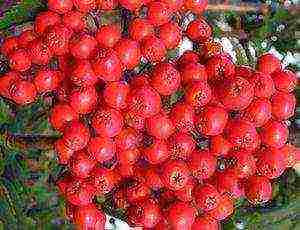 Medium late ripening variety. A tree of moderate growth, up to 6 m high. Crohn of medium density, regular wide pyramidal shape. Fruits with an average weight of 1.7 g, one-dimensional, cylindrical, flattened, with a calyx, with a smooth, slightly ribbed surface, regular shape and scarlet-red. The taste is sweet and sour, with a spicy mountain ash aftertaste. The variety tolerates frosts down to -50 ° С.
Medium late ripening variety. A tree of moderate growth, up to 6 m high. Crohn of medium density, regular wide pyramidal shape. Fruits with an average weight of 1.7 g, one-dimensional, cylindrical, flattened, with a calyx, with a smooth, slightly ribbed surface, regular shape and scarlet-red. The taste is sweet and sour, with a spicy mountain ash aftertaste. The variety tolerates frosts down to -50 ° С.
Titanium
 The tree is medium-sized, with a rounded crown of medium density. Height is about 5 meters. The crown is sparse, well formed in a natural way, requires only slight thinning. The variety is fast-growing, fruitful annually. Fruits with an average weight of 1.2 g, round, slightly ribbed, with a medium-sized straight peduncle. The color is dark cherry, with a waxy bloom. The pulp is intense yellow, medium density. The taste of the berries is sweet and sour with a slight astringency. Trees are resistant to adverse environmental factors: frost, drought, disease.
The tree is medium-sized, with a rounded crown of medium density. Height is about 5 meters. The crown is sparse, well formed in a natural way, requires only slight thinning. The variety is fast-growing, fruitful annually. Fruits with an average weight of 1.2 g, round, slightly ribbed, with a medium-sized straight peduncle. The color is dark cherry, with a waxy bloom. The pulp is intense yellow, medium density. The taste of the berries is sweet and sour with a slight astringency. Trees are resistant to adverse environmental factors: frost, drought, disease.
Twinkle
 A variety of early autumn ripening, universal use. The tree is medium-sized, with a rounded crown of medium density. The color of the fruit is yellowish-orange during ripening, and red-orange at maturity. The pulp is yellow, of medium density, loose, fine-grained, very juicy.The taste of the fruit is sweet and sour, with a weak aroma. The variety is winter-hardy, high heat resistance and drought resistance. Resistance to pests and diseases.
A variety of early autumn ripening, universal use. The tree is medium-sized, with a rounded crown of medium density. The color of the fruit is yellowish-orange during ripening, and red-orange at maturity. The pulp is yellow, of medium density, loose, fine-grained, very juicy.The taste of the fruit is sweet and sour, with a weak aroma. The variety is winter-hardy, high heat resistance and drought resistance. Resistance to pests and diseases.
The mountain ash is one of the first among fruit plants in terms of winter hardiness. It tolerates very harsh winters with temperatures up to minus 50 ° C quite well. It blooms late, which avoids damage from spring frosts. Most varieties of sweet-fruited mountain ash have a sweet dessert taste. The astringency inherent in wild mountain ash is absent. This means that varietal mountain ash can be eaten fresh in large quantities, as well as delicious jam, jam, marmalade, wine, tinctures; fruits can be soaked and dried. Rowan fruits are very rich in carotene, rare vitamin K1, vitamins C and P.
Burka
 A complex hybrid of alpine sorbaronia and common mountain ash. Becomes fruiting from 2-3 years. The tree is undersized, 1.5-2.5 m. The crown is compact. Leaves are simple, pinnate. The variety is highly winter-resistant. The yield is annual, stable, 40-60 kg of berries can be harvested from 1 plant. The taste is only slightly inferior to Dessertnaya. Fruits are medium in size, reddish brown, slightly tart. Stores well for 3-4 months.
A complex hybrid of alpine sorbaronia and common mountain ash. Becomes fruiting from 2-3 years. The tree is undersized, 1.5-2.5 m. The crown is compact. Leaves are simple, pinnate. The variety is highly winter-resistant. The yield is annual, stable, 40-60 kg of berries can be harvested from 1 plant. The taste is only slightly inferior to Dessertnaya. Fruits are medium in size, reddish brown, slightly tart. Stores well for 3-4 months.
Scarlet large
 Medium late ripening variety. A tree of moderate growth, up to 6 m high. Crohn of medium density, regular wide pyramidal shape. Fruits with an average weight of 1.7 g, one-dimensional, cylindrical, flattened, with a calyx, with a smooth, slightly ribbed surface, regular shape and scarlet-red. The taste is sweet and sour, with a spicy mountain ash aftertaste. The variety tolerates frosts down to -50 ° С.
Medium late ripening variety. A tree of moderate growth, up to 6 m high. Crohn of medium density, regular wide pyramidal shape. Fruits with an average weight of 1.7 g, one-dimensional, cylindrical, flattened, with a calyx, with a smooth, slightly ribbed surface, regular shape and scarlet-red. The taste is sweet and sour, with a spicy mountain ash aftertaste. The variety tolerates frosts down to -50 ° С.
Bead
 Medium-sized tree about 3 m high, with a rounded crown of medium density. A tree of moderate growth. Fruits are round, red, weighing up to 2 g. The pulp is creamy, very juicy, of medium density, sweet and sour taste without bitterness and astringency. The yield is high. Transportability is good. The fruit can be consumed fresh. The variety is sun-loving, frost and disease resistant.
Medium-sized tree about 3 m high, with a rounded crown of medium density. A tree of moderate growth. Fruits are round, red, weighing up to 2 g. The pulp is creamy, very juicy, of medium density, sweet and sour taste without bitterness and astringency. The yield is high. Transportability is good. The fruit can be consumed fresh. The variety is sun-loving, frost and disease resistant.
Pomegranate
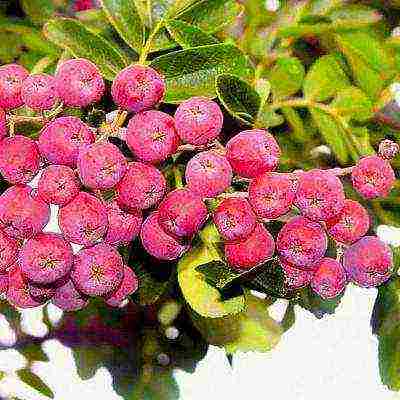 The variety combines the advantages of mountain ash and hawthorn. The plant is short and very decorative. The variety is winter-hardy, fruitful, with the largest fruits the size of a burgundy cherry. The taste of the berries is sweet and sour.
The variety combines the advantages of mountain ash and hawthorn. The plant is short and very decorative. The variety is winter-hardy, fruitful, with the largest fruits the size of a burgundy cherry. The taste of the berries is sweet and sour.
Vefed
 Rowan Vefed - medium ripening. The tree is medium-sized, with a sparse rounded crown, up to 4 m high. Fruits with an average weight of 1.3 g, one-dimensional, regular shape, rounded-pointed towards the base. Fruit color is elegant, pink-red. The pulp is yellow, tender, sweet and sour, pleasant when consumed fresh. It is characterized by stable fruiting, which enters into which for 3-4 years. The harvest ripens in the second half of August. Winter hardiness is high, relatively resistant to diseases and pests.
Rowan Vefed - medium ripening. The tree is medium-sized, with a sparse rounded crown, up to 4 m high. Fruits with an average weight of 1.3 g, one-dimensional, regular shape, rounded-pointed towards the base. Fruit color is elegant, pink-red. The pulp is yellow, tender, sweet and sour, pleasant when consumed fresh. It is characterized by stable fruiting, which enters into which for 3-4 years. The harvest ripens in the second half of August. Winter hardiness is high, relatively resistant to diseases and pests.
Sorbinka
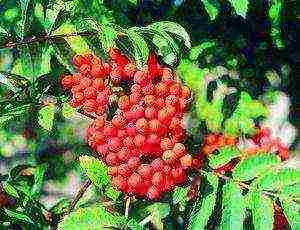 Variety of mid-autumn ripening, universal purpose. The tree is medium-sized with an obovate crown of medium density, the height of the tree is up to 6 m. It begins to bear fruit in the 4th year. Fruits are round, red, weighing up to 2.7 g. The pulp is yellowish, juicy, sweet and sour taste without astringency and bitterness. Location: in the sun. The variety is winter-hardy, highly adaptable, resistant to pests and diseases.
Variety of mid-autumn ripening, universal purpose. The tree is medium-sized with an obovate crown of medium density, the height of the tree is up to 6 m. It begins to bear fruit in the 4th year. Fruits are round, red, weighing up to 2.7 g. The pulp is yellowish, juicy, sweet and sour taste without astringency and bitterness. Location: in the sun. The variety is winter-hardy, highly adaptable, resistant to pests and diseases.
Dessert Michurina
 Miracle berry. A small tree with a height of 1.4-1.8 from year to year pleases with abundant and lush spring flowering, and in the summer at the end of July - August it lights up with many ruby large (up to 1.5-2 g) edible berries of a pleasant sweetish-tart taste. They are used as a source of vitamins, organic acids, biologically active substances and fresh minerals, in compotes, teas.
Miracle berry. A small tree with a height of 1.4-1.8 from year to year pleases with abundant and lush spring flowering, and in the summer at the end of July - August it lights up with many ruby large (up to 1.5-2 g) edible berries of a pleasant sweetish-tart taste. They are used as a source of vitamins, organic acids, biologically active substances and fresh minerals, in compotes, teas.
Likernaya Michurina
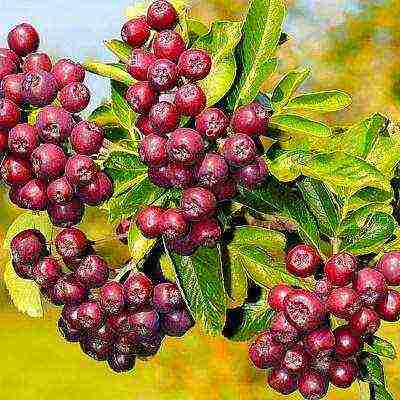 A tree up to 5 m high, with a sparse crown. Fruits are large, up to 15 mm in diameter, almost black, with dark-colored juice. The pulp is juicy, practically without astringency, rather sweet. Fruits 4–5 years after planting. Blooms in late May - early June. The fruits ripen in mid-September. Productivity and winter hardiness are high. May be severely affected by rot.Fresh fruits are stored for up to 1 month. The fruiting variety requires cross-pollination. The best pollinating varieties are Burka and Nevezhinskaya.
A tree up to 5 m high, with a sparse crown. Fruits are large, up to 15 mm in diameter, almost black, with dark-colored juice. The pulp is juicy, practically without astringency, rather sweet. Fruits 4–5 years after planting. Blooms in late May - early June. The fruits ripen in mid-September. Productivity and winter hardiness are high. May be severely affected by rot.Fresh fruits are stored for up to 1 month. The fruiting variety requires cross-pollination. The best pollinating varieties are Burka and Nevezhinskaya.
Cuba's daughter
 A variety of early autumn ripening period, universal purpose. The tree is medium-sized with a sparse paniculate crown. Begins fruiting in the 5th year. Fruits are oblong, bright orange, weighing up to 2 g. The pulp is bright yellow, without astringency and bitterness. Rowan bears fruit annually, gives up to 90 kg of fruits from a tree. Ripening period - mid-August. They are used fresh and for a wide variety of workpieces. Prefers loose soils, does not tolerate waterlogging.
A variety of early autumn ripening period, universal purpose. The tree is medium-sized with a sparse paniculate crown. Begins fruiting in the 5th year. Fruits are oblong, bright orange, weighing up to 2 g. The pulp is bright yellow, without astringency and bitterness. Rowan bears fruit annually, gives up to 90 kg of fruits from a tree. Ripening period - mid-August. They are used fresh and for a wide variety of workpieces. Prefers loose soils, does not tolerate waterlogging.
Sugar Petrova
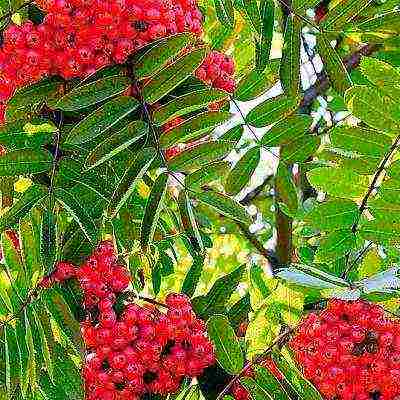 This is a very rare variety of sweet-fruited mountain ash. It was already almost irretrievably lost, but breeders managed to find and reproduce it. This mountain ash is the sweetest, it is really sugar. When at the end of October the garden is already completely empty, and there seems to be nothing to sweeten the dank autumn day, you will imperceptibly, handful by handful, send the berries of this magical variety into your mouth. And amazing grace will spread over your chilled body, life-giving sweetness will quickly restore your strength.
This is a very rare variety of sweet-fruited mountain ash. It was already almost irretrievably lost, but breeders managed to find and reproduce it. This mountain ash is the sweetest, it is really sugar. When at the end of October the garden is already completely empty, and there seems to be nothing to sweeten the dank autumn day, you will imperceptibly, handful by handful, send the berries of this magical variety into your mouth. And amazing grace will spread over your chilled body, life-giving sweetness will quickly restore your strength.
Nevezhinskaya
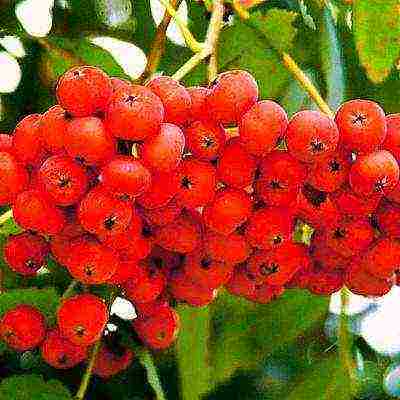 A variety of folk selection. The trees are vigorous, with a broadly rounded crown. The berries ripen from the end of August to the beginning of September. Fruits are medium in size. The taste is good, sweet and sour. The color of the fruit can vary from red to orange. The fruits of Nevezhinskaya are juicy, completely without astringency, very rich in biologically active substances. In terms of vitamin C content, its fruits can be equated to lemon. The best pollinator is Businka.
A variety of folk selection. The trees are vigorous, with a broadly rounded crown. The berries ripen from the end of August to the beginning of September. Fruits are medium in size. The taste is good, sweet and sour. The color of the fruit can vary from red to orange. The fruits of Nevezhinskaya are juicy, completely without astringency, very rich in biologically active substances. In terms of vitamin C content, its fruits can be equated to lemon. The best pollinator is Businka.
Solar
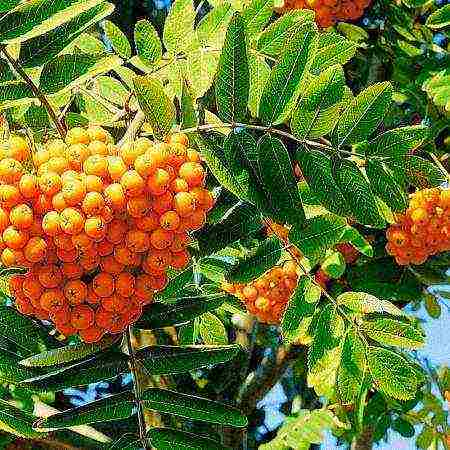 A very elegant, beautiful variety with bright orange oblong fruits weighing 1.8 g in a cherry blush. The taste is very pleasant, without astringency and bitterness. Ripens in mid-August. The use is universal, the "storehouse of vitamins" will find application everywhere. The tree is of moderate growth, winter-hardy.
A very elegant, beautiful variety with bright orange oblong fruits weighing 1.8 g in a cherry blush. The taste is very pleasant, without astringency and bitterness. Ripens in mid-August. The use is universal, the "storehouse of vitamins" will find application everywhere. The tree is of moderate growth, winter-hardy.
Moravian
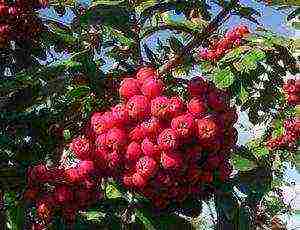 The plant has a pyramidal crown. Elliptical berries are raspberry colored. They are very sweet, with a light acidic note, without specific mountain ash astringency.
The plant has a pyramidal crown. Elliptical berries are raspberry colored. They are very sweet, with a light acidic note, without specific mountain ash astringency.
Many varieties of mountain ash look very beautiful in the garden. Plants with an unusual color of berries and beautiful clusters are of great interest.
Vefed
 A tree of medium growth with a round, thin crown, reaching a height of 4 m, with elongated, matte, dark green leaves. Rowan fruits Vefed are regular in shape, round, but pointed towards the base, with a medium-sized stalk, pink-red hue without subcutaneous dots and yellow sweet-sour pulp. Berries contain 96 mg of vitamin C and 32 mg of carotene. Fruiting begins in the 4th year. This variety for dessert purposes, is frost-resistant, resistant to diseases.
A tree of medium growth with a round, thin crown, reaching a height of 4 m, with elongated, matte, dark green leaves. Rowan fruits Vefed are regular in shape, round, but pointed towards the base, with a medium-sized stalk, pink-red hue without subcutaneous dots and yellow sweet-sour pulp. Berries contain 96 mg of vitamin C and 32 mg of carotene. Fruiting begins in the 4th year. This variety for dessert purposes, is frost-resistant, resistant to diseases.
Burka
 A complex hybrid of alpine sorbaronia and common mountain ash. Becomes fruiting from 2-3 years. The tree is undersized, 1.5-2.5 m. The crown is compact. Leaves are simple, pinnate. The variety is highly winter-resistant. The yield is annual, stable, 40-60 kg of berries can be harvested from 1 plant. The taste is only slightly inferior to Dessertnaya. Fruits are medium in size, reddish brown, slightly tart. Stores well for 3-4 months.
A complex hybrid of alpine sorbaronia and common mountain ash. Becomes fruiting from 2-3 years. The tree is undersized, 1.5-2.5 m. The crown is compact. Leaves are simple, pinnate. The variety is highly winter-resistant. The yield is annual, stable, 40-60 kg of berries can be harvested from 1 plant. The taste is only slightly inferior to Dessertnaya. Fruits are medium in size, reddish brown, slightly tart. Stores well for 3-4 months.
Gorgeous
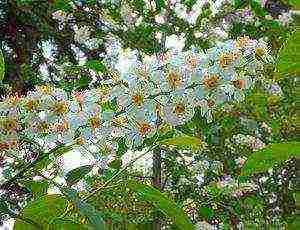 The Krasavitsa variety has unusual elongated fruits. They are painted bright orange. The pyramidal crown also supports decorative beauty.
The Krasavitsa variety has unusual elongated fruits. They are painted bright orange. The pyramidal crown also supports decorative beauty.
 The Scientific and Production Association "Sady Rossii" has been introducing the latest achievements in the selection of vegetable, fruit, berry and ornamental crops into the wide practice of amateur gardening for 30 years. In the work of the association, the most modern technologies are used, a unique laboratory for microclonal reproduction of plants has been created. The main tasks of NPO Sady Rossii is to provide gardeners with high-quality planting material for popular varieties of various garden plants and novelties of world selection. Delivery of planting material (seeds, onions, seedlings) is carried out by Russian post. We are waiting for you for shopping: NGO "Gardens of Russia"
The Scientific and Production Association "Sady Rossii" has been introducing the latest achievements in the selection of vegetable, fruit, berry and ornamental crops into the wide practice of amateur gardening for 30 years. In the work of the association, the most modern technologies are used, a unique laboratory for microclonal reproduction of plants has been created. The main tasks of NPO Sady Rossii is to provide gardeners with high-quality planting material for popular varieties of various garden plants and novelties of world selection. Delivery of planting material (seeds, onions, seedlings) is carried out by Russian post. We are waiting for you for shopping: NGO "Gardens of Russia"
Probably, there is not a single village or suburban area, wherever rowan grows. However, gardeners plant it more often for the sake of decorating the site. Meanwhile, there are varieties whose berries are not only attractive, but also very tasty! There is no bitterness in them at all.
Scarlet is large. A hybrid of a rowan with a pear. Its fruits are scarlet-red, juicy, with a slight astringency, but without bitterness. Tasters rate their taste at 4.3 points (out of 5). They are also very large, the size of a cherry (up to 4 g!). The first crop appears in the 3rd - 4th year. Up to 150 kg can be harvested from one adult plant.
The trees of this variety are quite tall - 5 - 6 m. Winter hardiness is simply amazing: the tree can easily withstand frosts down to -50 ° C. It is almost not affected by pests or diseases.
Bead. This variety has standard fruits in size (about 1 g) and color, but their taste is atypical, reminiscent of cranberries, only sweeter (taste rating 4.3 points). Bears fruit in the 4th - 5th year. Productivity up to 70 kg.
The trees are not tall (2.5 - 3 m), winter-hardy, disease-resistant.
Vefed. The fruits are very elegant - orange-pink, shiny, weighing up to 1.3 g. Taste rating 4.6 points - this is the sweetest of all existing mountain ash! Begins to bear fruit in the 4th - 5th year. Productivity up to 80 kg per plant.
The trees are not tall, 3 - 3.5 m. Frosts, even the most fierce ones, are not afraid of them. Resistance to pests and diseases is high.
Pomegranate. A hybrid of mountain ash with large-fruited hawthorn. Her fruits are of an unusual burgundy color. The taste is sweet and sour, with a slight astringency (4.3 points). Quite large (up to 2 g). The first crop gives in the 3rd year. One plant can collect 20 - 25 kg of berries.
The height of the trees is 3 - 4 m. Winter hardiness is high.
Kubova's daughter (Solar). The fruits of this variety are large (1.8 g), bright orange, with an original reddish blush. The pulp is very juicy, tender, without astringency and bitterness. Taste score 4.5 points. Begins to bear fruit in the 5th year. Productivity up to 90 kg. Trees 3 - 4 m high.
Michurinskaya dessert.A hybrid of mountain ash with medlar. Its fruits weigh up to 1.5 g, dark ruby color. According to the taste, as the author of this variety, Ivan Michurin, wrote, "sweet taste, with very weak bitterness, which gives the fruit a peculiar delicate piquant taste." Begins to bear fruit in the 4th year. Productivity up to 70 kg.
Ideal for small areas as the trees are only 1.5 - 2 m tall.
Ruby. Fruits are medium in size (1.3 g), dark ruby color. The pulp is juicy, sweet and sour taste, with a weak aroma (4 points). The first berries appear in the 3rd - 4th year. The yield of the variety is very high - up to 120 kg.
The trees are not high, about 2 m. It tolerates frost perfectly.
Sorbinka. The fruits are very large, with an average weight of 2.7 g, red in color with a slight yellowish tinge. Delicate, juicy, pleasant refreshing sweet and sour taste without astringency and bitterness (4.4 points). Fruiting in the 5th - 6th year. Productivity up to 120 kg.
Sorbinka grows up to 3 m. It is resistant to frost, pests and diseases.
Titanium. Hybrid of mountain ash with pear and red-leaved apple tree. Fruits are dark red with a bluish bloom, weighing up to 2 g. The pulp is juicy, sweet and sour taste, with a slight astringency (score 3.7 points). The first harvest gives in the 3rd - 4th year. Up to 70 kg can be harvested from one plant.
Trees 3 - 3.5 m high. The variety is very resistant to various extreme conditions (frost, drought, disease).
And also Titan berries have an amazing property: they are stored for up to 8 - 9 months! In other varieties, fruits do not last more than 30 days.
Alexey VOLODIKHIN,


